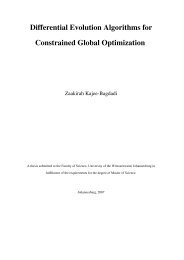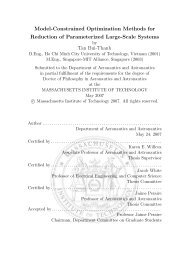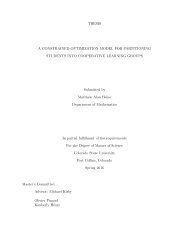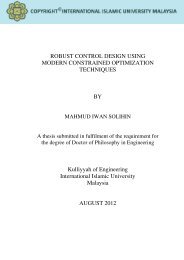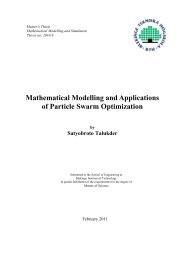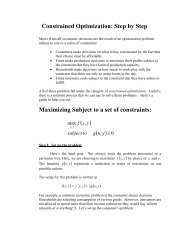IJCSE10-01-03-29
You also want an ePaper? Increase the reach of your titles
YUMPU automatically turns print PDFs into web optimized ePapers that Google loves.
Pratibha Bajpai et al. / Indian Journal of Computer Science and Engineering<br />
Vol 1 No 3 199-206<br />
Genetic Algorithm – an Approach to Solve Global Optimization Problems<br />
PRATIBHA BAJPAI<br />
Amity Institute of Information Technology, Amity University,<br />
Lucknow, Uttar Pradesh, India, pratibha_bajpai@rediffmail.com<br />
DR. MANOJ KUMAR<br />
LBSIMDS,<br />
Lucknow, Uttar Pradesh, India,<br />
mauryamanoj2008@rediffmail.com<br />
Abstract<br />
The genetic algorithm (GA) is a search heuristic that is routinely used to generate useful solutions to optimization and search problems. It<br />
generates solutions to optimization problems using techniques inspired by natural evolution, such as inheritance, mutation, selection, and<br />
crossover. Genetic algorithms are one of the best ways to solve a problem for which little is known. They are a very general algorithm and so<br />
work well in any search space. All you need to know is what you need the solution to be able to do well, and a genetic algorithm will be able to<br />
create a high quality solution.<br />
Keywords: Global Optimization; Genetic Algorithms; Rastrigin's function<br />
1.0 Introduction<br />
Darwin’s theory of Evolution states that all life is related and has descended from a common ancestor. The theory<br />
presumes that complex creatures have evolved from more simplistic ancestors naturally over time. In a nutshell, as<br />
random genetic mutations occur within an organism's genetic code, the beneficial mutations are preserved because<br />
they aid survival -- a process known as "natural selection." These beneficial mutations are passed on to the next<br />
generation. Over time, beneficial mutations accumulate and the result is an entirely different organism.<br />
Genetic algorithms are adaptive heuristic search algorithm premised on the Darwin’s evolutionary ideas of natural<br />
selection and genetic. The basic concept of genetic algorithms is designed to simulate processes in natural system<br />
necessary for evolution. As such they represent an intelligent exploitation of a random search within a defined<br />
search space to solve a problem. First pioneered by John Holland in the 60’s, GAs has been widely studied,<br />
experimented and applied in many fields in engineering world. Not only does genetic algorithm provide an<br />
alternative method to solving problem, it consistently outperforms other traditional methods in most of the problems<br />
link. Many of the real world problems which involve finding optimal parameters might prove difficult for traditional<br />
methods but are ideal for genetic algorithms. This paper starts with the description of various GA operators in<br />
section 2. Section 3 gives the outline of the genetic algorithm. In section 4, we introduce global optimization and<br />
discuss how genetic algorithm can be used to achieve global optimization and illustrate the concept with the help of<br />
Rastrigin’s function. In section 5, we explore the reasons why GA is a good optimization tool. The discussion ends<br />
with a conclusion and future trend.<br />
2.0 Genetic Algorithm<br />
A population of individuals is maintained within search space for a GA, each representing a possible solution to a<br />
given problem. Each individual is coded as a finite length vector of components, or variables, in terms of some<br />
alphabet, usually the binary alphabet {0,1}. To continue the genetic analogy these individuals are likened to<br />
chromosomes and the variables are analogous to genes. Thus a chromosome (solution) is composed of several genes<br />
(variables).<br />
ISSN : 0976-5166 199
Pratibha Bajpai et al. / Indian Journal of Computer Science and Engineering<br />
Vol 1 No 3 199-206<br />
The chromosome then looks like this:<br />
Chromosome 1 11<strong>01</strong>10<strong>01</strong>0<strong>01</strong>1<strong>01</strong>10<br />
Chromosome 2 11<strong>01</strong>111000<strong>01</strong>1110<br />
Each chromosome has one binary string. Each bit in this string can represent some characteristic of the solution.<br />
Of course, there are many other ways of encoding. This depends mainly on the solved problem. For example, one<br />
can encode directly integer or real numbers; sometimes it is useful to encode some permutations and so on.<br />
2.1 Initialization<br />
Initially many individual solutions are randomly generated to form an initial population. The population size<br />
depends on the nature of the problem, but typically contains several hundreds or thousands of possible solutions.<br />
Traditionally, the population is generated randomly, covering the entire range of possible solutions (the search<br />
space). Occasionally, the solutions may be "seeded" in areas where optimal solutions are likely to be found.<br />
2.3 Selection<br />
During each successive generation, a proportion of the existing population is selected to breed a new generation.<br />
Individual solutions are selected through a fitness-based process, where fitter solutions (as measured by a fitness<br />
function) are typically more likely to be selected. Certain selection methods rate the fitness of each solution and<br />
preferentially select the best solutions. Other methods rate only a random sample of the population, as this process<br />
may be very time-consuming.<br />
Most functions are stochastic and designed so that a small proportion of less fit solutions are selected. This helps<br />
keep the diversity of the population large, preventing premature convergence on poor solutions. Popular and wellstudied<br />
selection methods include roulette wheel selection and tournament selection.<br />
2.3.1 Roulette Wheel Selection:<br />
• Fitness level is used to associate a probability of selection with each individual solution.<br />
• We first calculate the fitness for each input and then represent it on the wheel in terms of percentages.<br />
• In a search space of ‘N’ chromosomes, we spin the roulette wheel.<br />
• Chromosome with bigger fitness will be selected more times.<br />
ISSN : 0976-5166 200
Pratibha Bajpai et al. / Indian Journal of Computer Science and Engineering<br />
Vol 1 No 3 199-206<br />
X = Value10normalized between 0 to 10 range<br />
Value10: Value of chromosome to the base 10<br />
Fig 1. Roulette Wheel selection<br />
2.3.2 Tournament Selection:<br />
•Two solutions are picked out of the pool of possible solutions, their fitness is compared, and the better is permitted<br />
to reproduce.<br />
•Deterministic tournament selection selects the best individual in each tournament.<br />
•Can take advantage of parallel architecture<br />
2.4 Crossover<br />
Next step is to perform crossover. This operator selects genes from parent chromosomes and creates a new<br />
offspring. The simplest way how to do this is to choose randomly some crossover point and everything before<br />
this point copy from a first parent and then everything after a crossover point copy from the second parent.<br />
Crossover can then look like this (| is the crossover point):<br />
Table 1: Single Point Crossover<br />
Chromosome 1 11<strong>01</strong>1 | 0<strong>01</strong>0<strong>01</strong>1<strong>01</strong>10<br />
Chromosome 2 11<strong>01</strong>1 | 11000<strong>01</strong>1110<br />
Offspring 1 11<strong>01</strong>1 | 11000<strong>01</strong>1110<br />
Offspring 2 11<strong>01</strong>1 | 0<strong>01</strong>0<strong>01</strong>1<strong>01</strong>10<br />
ISSN : 0976-5166 2<strong>01</strong>
Pratibha Bajpai et al. / Indian Journal of Computer Science and Engineering<br />
Vol 1 No 3 199-206<br />
There are other ways how to make crossover, for example we can choose more crossover points. Crossover can be<br />
rather complicated and very depends on encoding of the chromosome. Specific crossover made for a specific<br />
problem can improve performance of the genetic algorithm.<br />
2.5 Mutation<br />
After a crossover is performed, mutation takes place. This is to prevent falling all solutions in population into a<br />
local optimum of solved problem. Mutation changes randomly the new offspring. For binary encoding we can<br />
switch a few randomly chosen bits from 1 to 0 or from 0 to 1. Mutation can then be following:<br />
Table 2: Mutation<br />
Original offspring 1 11<strong>01</strong>111000<strong>01</strong>1110<br />
Original offspring 2 11<strong>01</strong>10<strong>01</strong>0<strong>01</strong>1<strong>01</strong>10<br />
Mutated offspring 1 110<strong>01</strong>11000<strong>01</strong>1110<br />
Mutated offspring 2 11<strong>01</strong>1<strong>01</strong>10<strong>01</strong>1<strong>01</strong>10<br />
The mutation depends on the encoding as well as the crossover. For example when we are encoding<br />
permutations, mutation could be exchanging two genes.<br />
Fig 2: Genetic Algorithm Cycle<br />
*Phenotype is the coding scheme used to represent the chromosomes.<br />
3.0 Outline of the Basic Genetic Algorithm<br />
1. [Start] Generate random population of n chromosomes (suitable solutions for the problem)<br />
2. [Fitness] Evaluate the fitness f(x) of each chromosome x in the population<br />
3. [New population] Create a new population by repeating following steps until the new population is<br />
complete<br />
3.1 [Selection] Select two parent chromosomes from a population according to their fitness (the better fitness,<br />
the bigger chance to be selected)<br />
3.2 [Crossover] With a crossover probability cross over the parents to form a new offspring (children). If no<br />
crossover was performed, offspring is an exact copy of parents.<br />
ISSN : 0976-5166 202
Pratibha Bajpai et al. / Indian Journal of Computer Science and Engineering<br />
Vol 1 No 3 199-206<br />
3.3 [Mutation] With a mutation probability mutate new offspring at each locus (position in chromosome).<br />
3.4 [Accepting] Place new offspring in a new population<br />
4. [Replace] Use new generated population for a further run of algorithm<br />
5. [Test] If the end condition (for example number of populations or improvement of the best solution) is<br />
satisfied, stop, and return the best solution in current population<br />
6. [Loop] Go to step 2<br />
4.0 Global Optimization by Genetic Algorithm<br />
Optimization is the science of finding decisions that satisfy given constraints, and meet a specific goal at its optimal<br />
value. In engineering, constraints may arise from physical limitations and technical specifications; in business,<br />
constraints are often related to resources, including manpower, equipment, costs, and time.<br />
The objective of global optimization is to find the "best possible" solution in nonlinear decision models that<br />
frequently have a number of sub-optimal (local) solutions. In the absence of global optimization tools, engineers and<br />
researchers are often forced to settle for feasible solutions, often neglecting the optimum values. In practical terms,<br />
this implies inferior designs and operations, and related expenses in terms of reliability, time, money, and other<br />
resources.<br />
The classical optimization techniques have difficulties in dealing with global optimization problems. One of the<br />
main reasons of their failure is that they can easily be entrapped in local minima. Moreover, these techniques cannot<br />
generate or even use the global information needed to find the global minimum for a function with multiple local<br />
minima.<br />
The genetic algorithm solves optimization problems by mimicking the principles of biological evolution, repeatedly<br />
modifying a population of individual points using rules modeled on gene combinations in biological reproduction.<br />
Due to its random nature, the genetic algorithm improves the chances of finding a global solution. Thus they prove<br />
to be very efficient and stable in searching for global optimum solutions. It helps to solve unconstrained, boundconstrained,<br />
and general optimization problems, and it does not require the functions to be differentiable or<br />
continuous.<br />
We next discuss an example that shows how to find the global minimum of Rastrigin's function using genetic<br />
algorithm. For two independent variables, Rastrigin’s function is defined as<br />
ISSN : 0976-5166 2<strong>03</strong>
Pratibha Bajpai et al. / Indian Journal of Computer Science and Engineering<br />
Vol 1 No 3 199-206<br />
Fig 3: Global minimum of Rastrigin’s Function<br />
As the plot shows, Rastrigin's function has many local minima—the "valleys" in the plot. However, the function has<br />
just one global minimum, which occurs at the point [0 0] in the x-y plane, as indicated by the vertical line in the plot,<br />
where the value of the function is 0. At any local minimum other than [0 0], the value of Rastrigin's function is<br />
greater than 0. The farther the local minimum is from the origin, the larger the value of the function is at that point.<br />
The following contour plot of Rastrigin's function shows the alternating maxima and minima.<br />
Fig 4: Contour Plot of Rastrigin’s function<br />
ISSN : 0976-5166 204
Pratibha Bajpai et al. / Indian Journal of Computer Science and Engineering<br />
Vol 1 No 3 199-206<br />
The final value of the fitness function (Rastrigin's function) when the algorithm terminated:<br />
Objective function value: 0.055316021<strong>01</strong>322264<br />
The value obtained is very close to the actual minimum value of Rastrigin's function, which is 0.<br />
Fig 5: Plot of the best and mean values of the fitness function at each generation.<br />
Source: www.mathworks.com/products/global-optimization<br />
The points at the bottom of the plot denote the best fitness values, while the points above them denote the averages<br />
of the fitness values in each generation. The plot also displays the best and mean values in the current generation<br />
numerically at the top.<br />
5.0 What makes GA a Good Global Optimization Tool?<br />
<br />
<br />
<br />
The first and most important point is that genetic algorithms are intrinsically parallel. Most other<br />
algorithms are serial and can only explore the solution space to a problem in one direction at a time, and if<br />
the solution they discover turns out to be suboptimal, there is nothing to do but abandon all work previously<br />
completed and start over. However, since GA has multiple offspring, they can explore the solution space in<br />
multiple directions at once. If one path turns out to be a dead end, they can easily eliminate it and continue<br />
work on more promising avenues, giving them a greater chance each run of finding the optimal solution.<br />
Due to the parallelism that allows them to implicitly evaluate many schemas at once, genetic algorithms are<br />
particularly well-suited to solving problems where the space of all potential solutions is truly huge - too<br />
vast to search exhaustively in any reasonable amount of time. It directly samples only small regions of the<br />
vast fitness landscape and successfully finds optimal or very good results in a short period of time after<br />
directly.<br />
Another notable strength of genetic algorithms is that they perform well in problems for which the fitness<br />
landscape is complex - ones where the fitness function is discontinuous, noisy, changes over time, or has<br />
ISSN : 0976-5166 205
Pratibha Bajpai et al. / Indian Journal of Computer Science and Engineering<br />
Vol 1 No 3 199-206<br />
<br />
<br />
many local optima. GA has proven to be effective at escaping local optima and discovering the global<br />
optimum in even a very rugged and complex fitness landscape. However, even if a GA does not always<br />
deliver a provably perfect solution to a problem, it can almost always deliver at least a very good solution.<br />
Another area in which genetic algorithms excel is their ability to manipulate many parameters<br />
simultaneously. GAs are very good at solving such problems, in particular, their use of parallelism enables<br />
them to produce multiple equally good solutions to the same problem, possibly with one candidate solution<br />
optimizing one parameter and another candidate optimizing a different one and a human overseer can then<br />
select one of these candidates to use.<br />
Finally, one of the qualities of genetic algorithms which might at first appear to be a liability turns out to be<br />
one of their strengths, namely, GAs know nothing about the problems they are deployed to solve. Instead of<br />
using previously known domain-specific information to guide each step, they make random changes to<br />
their candidate solutions and then use the fitness function to determine whether those changes produce an<br />
improvement.<br />
6.0 Conclusion<br />
The problem of finding the global optimum in a space with many local optima is a classic problem for all systems<br />
that can adapt and learn. GA provides a comprehensive search methodology for optimization. GA is applicable to<br />
both continuous and discrete optimization problems. In global optimization scenarios, GAs often manifests their<br />
strengths: efficient, parallelizable search; the ability to evolve solutions with multiple objective criteria; and a<br />
characterizable and controllable process of innovation.<br />
7.0 Future Trends<br />
Some limitations of GAs are that in certain situations, they are overkill compared to more straightforward<br />
optimization methods such as hill-climbing, feed forward artificial neural networks using backpropagation, and even<br />
simulated annealing and deterministic global search. To make genetic algorithm more effective and efficient it can<br />
be incorporated with other techniques within its framework to produce a hybrid genetic algorithm that can reap best<br />
from its combination. Hybrid genetic algorithms have received significant interest in recent years and are being<br />
increasingly used to solve real-world problems quickly, reliably and accurately without the need for any forms of<br />
human intervention. More research needs to be concentrated on the development of hybrid design alternatives for its<br />
efficiency enhancement.<br />
References:<br />
[1] Charles C. Peck, Atam P. Dhawan, “Genetic algorithms as global random search methods: An alternative perspective”,<br />
Evolutionary Computation, Volume 3 Issue 1, MIT Press, March 1995.<br />
[2] D. E. Goldberg, “Genetic Algorithms in Search, Optimization and Machine Learning”, Addison Wesley Publishing<br />
Company, Ind. USA, 1989.<br />
[3] http://mathworld.wolfram.com/GlobalOptimization.html.<br />
[4] http://www.maplesoft.com/products/toolboxes/globaloptimization<br />
[5] L.Painton, J.Campbell, “Genetic algorithms in optimization of system reliability” Reliability, IEEE Transactions on<br />
Volume: 44 , Issue: 2, Digital Object Identifier: 10.1109/24.387368, Publication Year: 1995 , Page(s): 172 – 178<br />
[6] L. T. Leng, Guided genetic algorithm, Doctoral Dissertation. University of Essex, 1999.<br />
[7] M. Syrjakow and H. Szczerbicka, “Combination of direct global and local optimization methods”, in IEEE Conference on<br />
Evolutionary Computation. Perth, Western Australia: IEEE, 1995, pp. 326-333.<br />
[8] Melanie Mitche, “An introduction to genetic algorithm”, MIT press, 1998.<br />
[9] P. Larrañaga, C. M. H. Kuijpers, R. H. Murga, I. Inza, S. Dizdarevic, “Genetic Algorithms for the Travelling Salesman<br />
Problem: A Review of Representations and Operators”, Artificial Intelligence Review , Volume 13 Issue 2, Kluwer<br />
Academic Publishers, April 1999.<br />
[10] R. Fletcher, “Practical Methods of Optimization”, John Willey & Sons, 1986.<br />
[11] T. Weise, “Global Optimization Algorithms - Theory and Application”. Available online at www.itweise.de/projects/book.pdf<br />
[12] Törn and A. Zilinskas, Global optimization, in Lecture Notes in Computer Science, vol. 350: Springer-Verlag, 1989.<br />
ISSN : 0976-5166 206



